The New York Crystal Palace Destroyed (Part 2)
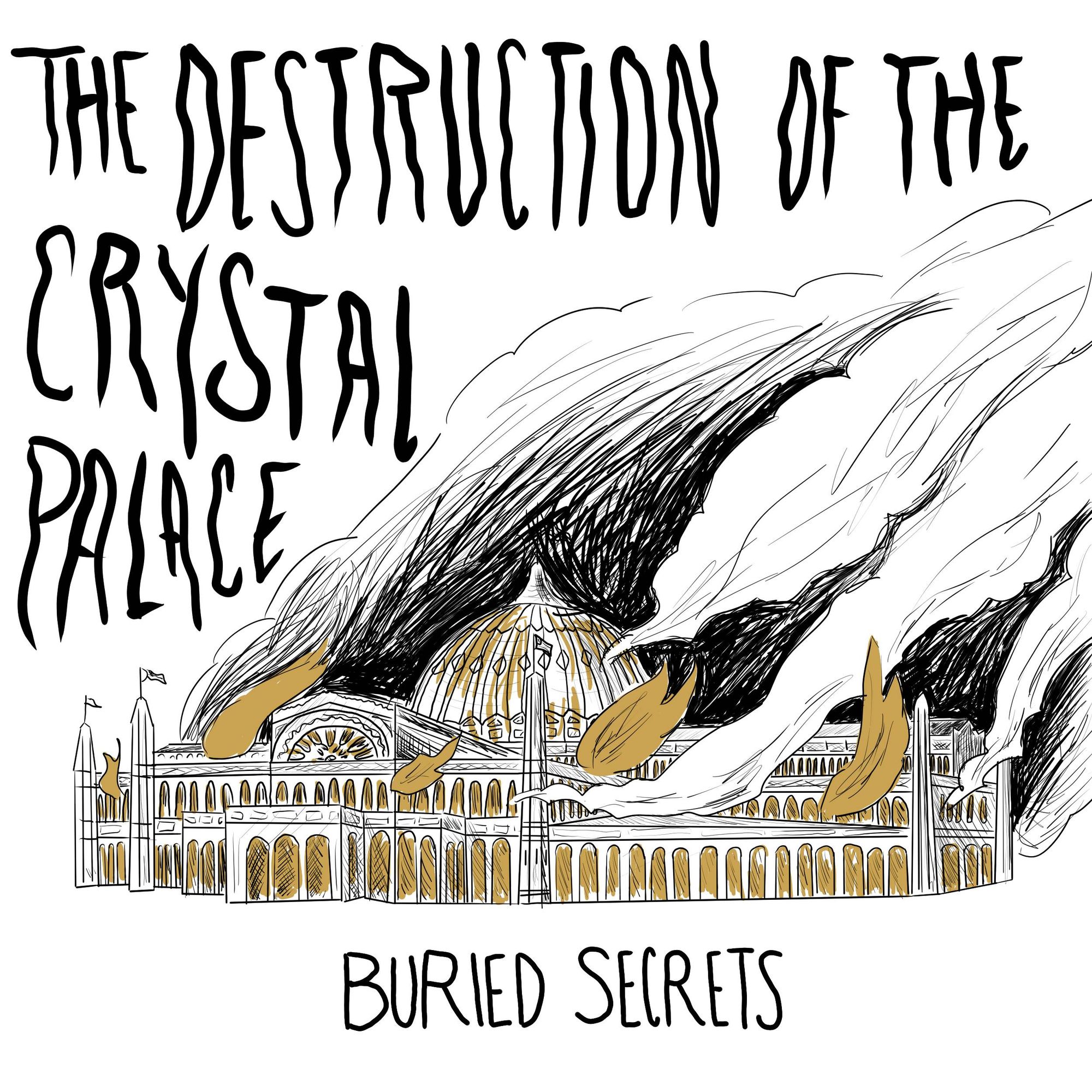
It only took 15 minutes for the New York Crystal Palace, a beautiful building made of iron and glass, to be destroyed.
Financially insolvent and falling apart, the building had seen better days. New management attempted to save the beautiful edifice, but its ruin was too far gone. What had once been a glamorous tourist attraction became a decrepit mess.
New York City considered selling it for scraps, or moving the building to Philadelphia, but the screws that kept it together had rusted, making the Crystal Palace too expensive to even take apart. It was almost a blessing when a fire–which was blamed on arson but was more likely the rest of some cost-saving compromises on the gas lines–burned the building to the ground.
But, as the New York Tribune said: “We shall never have another Crystal palace. Its glorious dome . . . is no more; its galleries, its treasures, its magnificent expanses indispensable to the mass-gatherings of this great metropolis–its superb memories are all gone, and gone forever.”
Highlights include:
• PT Barnum’s attempts to save the Crystal Palace
• An elevator safety demonstration that involved repeatedly cutting the cord
• An exclusive gala organized by conmen and ending in a brawl between ultra-wealthy guests
• How a sensation like the Crystal Palace could have been forgotten
Follow the podcast on instagram @buriedsecretspodcast
E-mail the podcast at buriedsecretspodcast@gmail.com.
Pictures of the New York Crystal Palace Destroyed
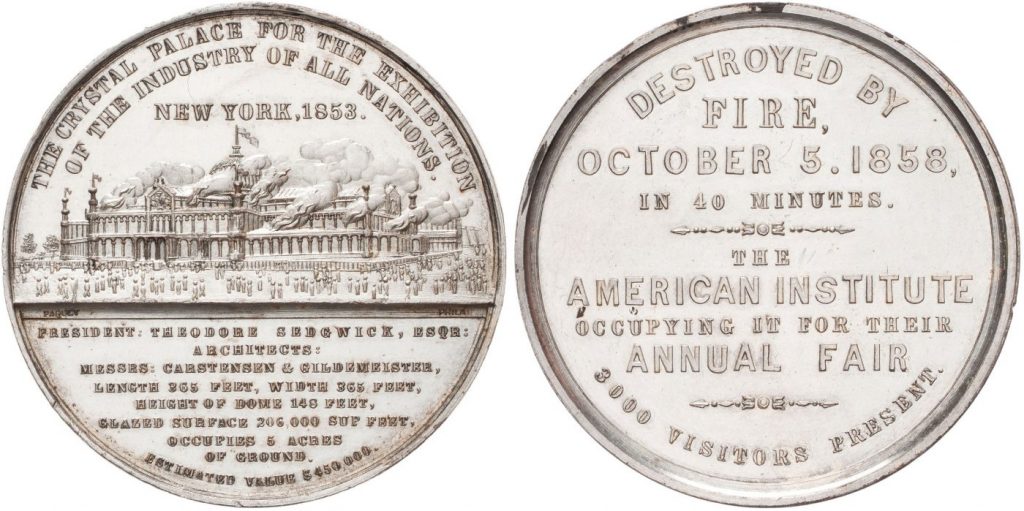
Souvenir coin (source: Museum of the City of New York)
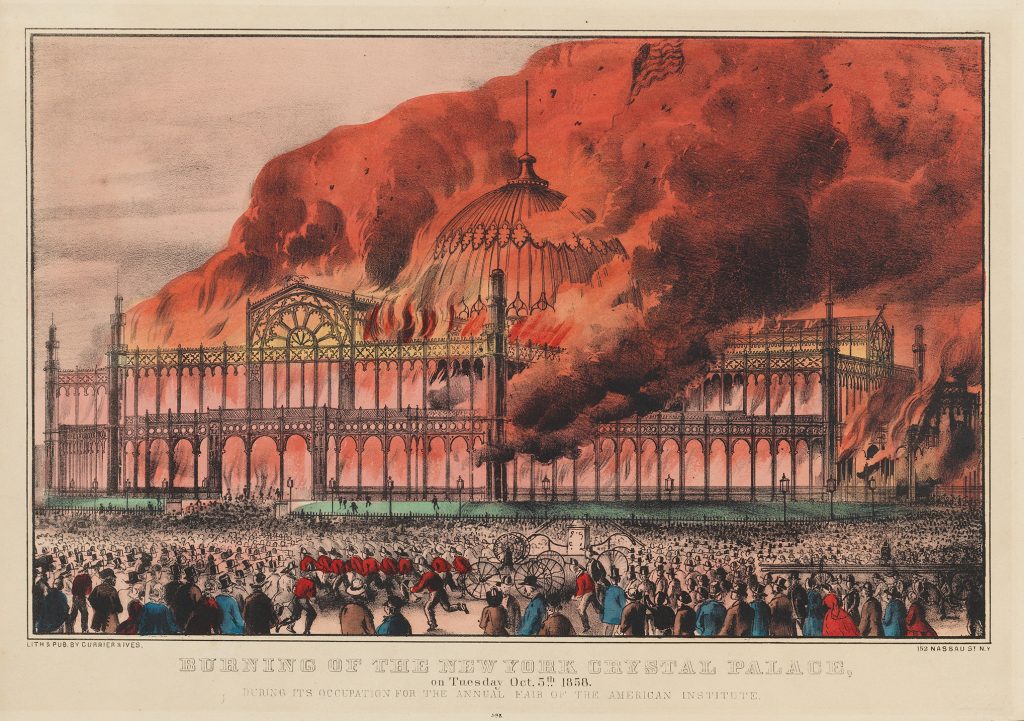
(source: Museum of the City of New York)
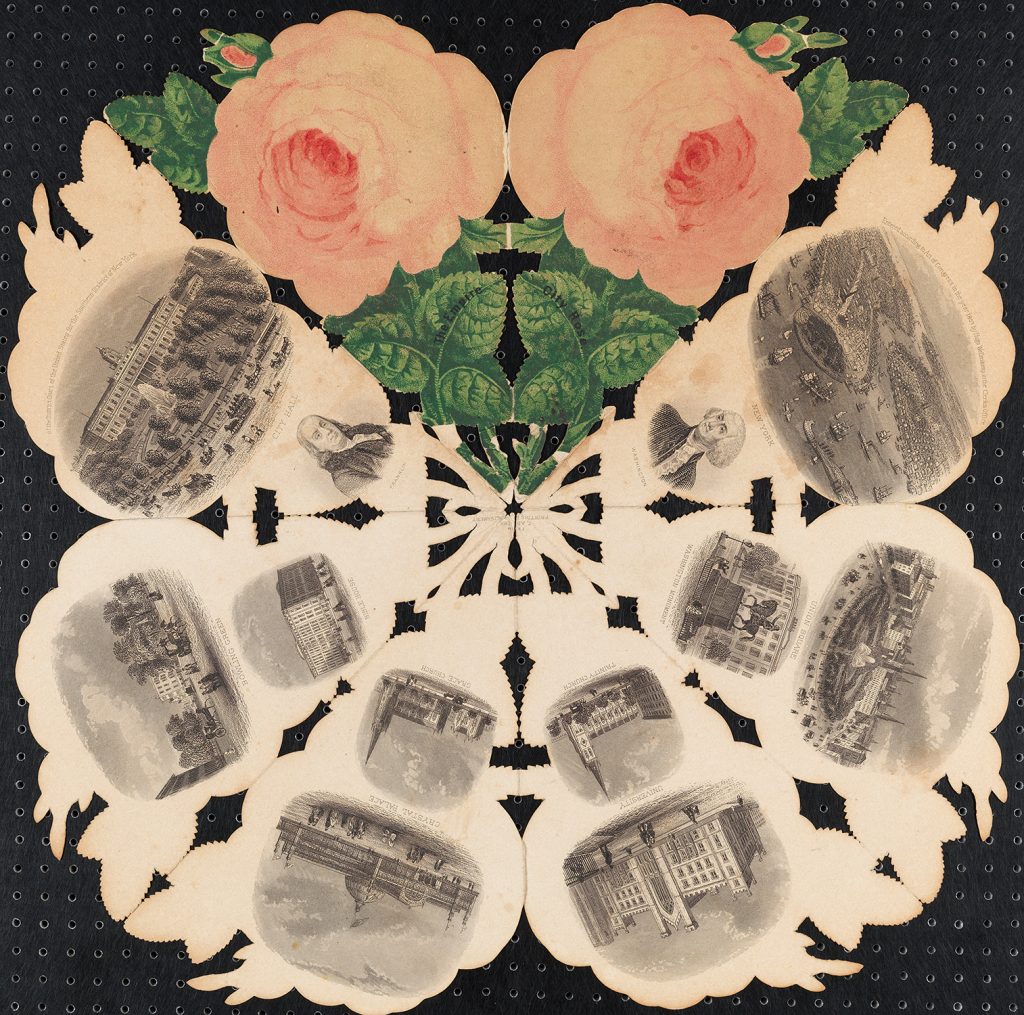
Folded souvenir with views of New York buildings, including the Crystal Palace, 1857. (source: Museum of the City of New York)
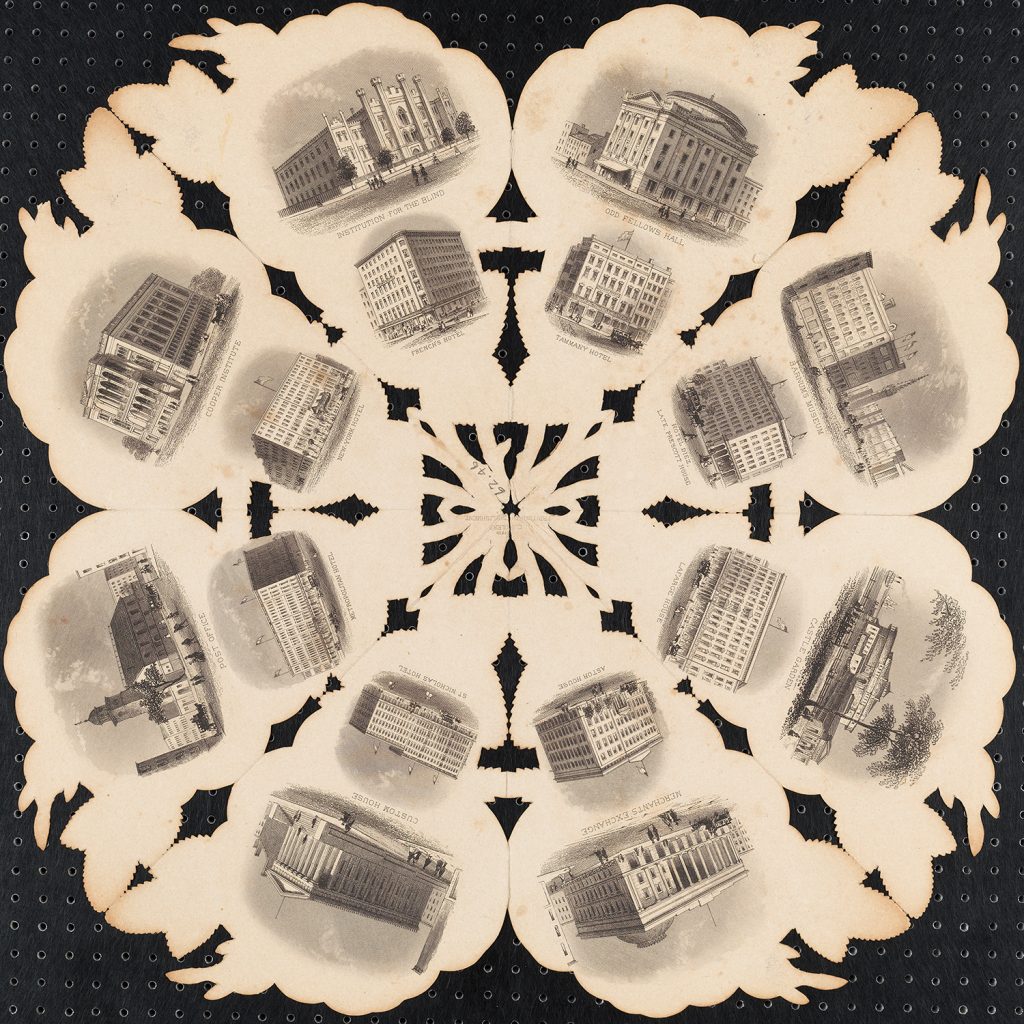
Folded souvenir with views of New York buildings, 1857. (source: Museum of the City of New York)
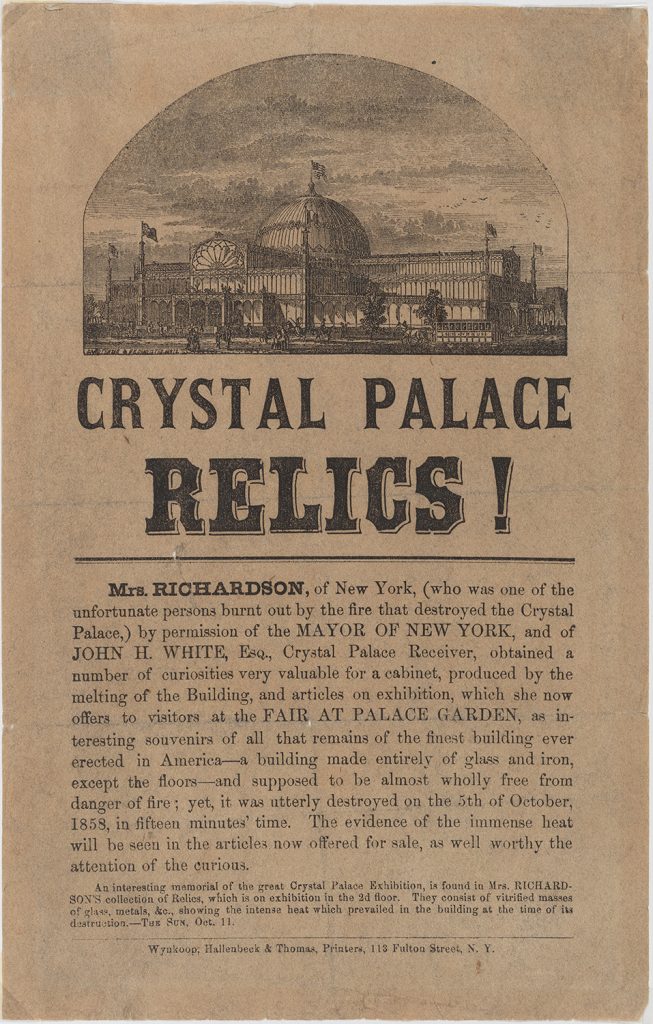
Flyer for a sale of relics (source: Museum of the City of New York)
Episode Script for The New York Crystal Palace Destroyed (Part 2)
DISCLAIMER: I’m providing this version of the script for accessibility purposes. It hasn’t been proofread, so please excuse typos. There are also some things that may differ between the final episode and this draft script. Please treat the episode audio as the final product.
“Your chief motive, of course, in coming to New York at the present time, was to see the Crystal Palace. Not that you had any very correct or decided idea as to what the Crystal Palace was or is—but that, as every body has been for some months past talking and writing about the Crystal Palace, and as you have been told that all the world is to be there, you naturally feel that you ought to be there too ; and so, here you are.”
-Fifteen Minutes Around New York by George G. Foster, 1854
“The old burial ground was built over briefly during the 1853 World’s Fair by New York’s own magnificent Crystal Palace, which burnt down in 1858. Over one million people visited the Crystal Palace during the fair; over one million walked across another of New York’s forgotten burial grounds.” -Peripheral Memory: New York’s Forgotten Landscape by Deborah Ann Buelow
“For some time to come — the Crystal Palace will be the great crowning object of attraction to all classes.” -New-York in a nutshell
“Crystal Palace Relics! Mrs. Richardson, of New York (who was one of the unfortunate persons burnt out by the fire that destroyed the Crystal Palace,) by permission of the MAYOR OF NEW YORK, and of John H. White, Esq., Crystal Palace Receiver, obtained a number of curiosities very valuable for a cabinet, produced by the melting of the Building, and articles on exhibition, which she now offers to visitors at the FAIR AT PALACE GARDEN, as interesting souvenirs of all that remains of the finest building ever erected in America–a building made entirely of glass and iron, except the floors–and supposed to be almost wholly free from danger of fire; yet, it was utterly destroyed on the 5th of October, 1858, in fifteen minutes’ time.” -an advertisement for a sale of Crystal Palace Souvenirs
“Crystal Palace Relics! Mrs. Richardson, of New York . . . obtained a number of curiosities very valuable for a cabinet, produced by the melting of the Building . . . which she now offers to visitors . . . as interesting souvenirs of all that remains of the finest building ever erected in America–a building made entirely of glass and iron, except the floors–and supposed to be almost wholly free from danger of fire; yet, it was utterly destroyed . . . in fifteen minutes’ time.” -an advertisement for a sale of Crystal Palace Souvenirs
- Barnum made a lot of sense as a board member: he was very rich, and more importantly, he knew how to put on a good show and draw people in. However, he was also famous for his hoaxes and weird novelty displays, like the time he displayed a “Feejee Mermaid” that was really a mummified monkey sewn onto a fish tale, among many other hoaxes and creative flourishes to charm the masses.
- I do think that a lot of the opposition to Barnum being on the board was because he was kinda a crass showman who didn’t seem to despise ordinary people, at least not the same way a lot of wealthy people did. If the goal of the exhibition was to train people to have good taste, bringing Barnum on wasn’t exactly a recipe for that.
- One stockholder said that the palace should be “an arena for artistic competition, and not a mere toy shop for common huckstering” as a dig against Barnum (FBA 149)
- Barnum wasn’t totally thrilled with the idea, though.
- Originally, back in 1851, he’d been asked to help create NYC’s Crystal Palace, but Barnum thought it was a bad idea: he said it was too soon after London’s Crystal Palace, and that it’d lose money
- Barnum claims that he took on his new role on the Crystal Palace board “much against my own judgement”, and a week after he joined, he was asked to become president of the Association
- He agreed grudgingly, but demanded to examine the books, and said he’d quit if he didn’t like what he saw
- I guess he was okay with the books, because he spent a few months revitalizing the Crystal Palace–or trying to.
- He loaned what were supposedly large amounts of his personal fortune so the Association could pay their creditors (he got a $40K mortgage on the Crystal Palace in exchange for that)
- He raised money by getting hotels and railroads to buy tons of tickets in advance
- He also let exhibitors show their wares for free and advertise their prices (making it sort of more like a mall, than a museum), he negotiated with train and steamboat companies to get reduced fares between NYC and popular vacation spots like Newport and Cape May, made admission cheaper, and said that the “refreshmen saloons” would have reasonably priced snacks
- He made alterations to the building, closing it for a month, before what was set to be a big re-inaguration
- He would later claim that “I never labored so hard, night and day.”
- Things went better for Barnum than for the previous president, but he still encountered issues
- The publisher of Scientific American, sued the Association, saying it’d borrowed too much money and violated its charter, and an injunction related to that made it hard to settle the Associations debts
- A six-person envoy from England had checked out the Crystal Palace, and they published their very negative report about the exhibition. To be fair, it was kinda a mess: for example, when they got to the states, the exhibition wasn’t even ready, so the group had to split up and travel all over the country
- The night before the big re-opening in May 1854, there was a very heavy rainstorm, but apparently Barnum was there, bright eyed and bushy tailed, waving his umbrella around and getting everyone into position. It was a parade that included a band, veterans, clergymen, government employees, tradesmen, etc.
- The crowd of 10,000 people who gathered at reservoir square to watch the parade was smaller than expected, and when it started drizzling again, people with tickets went in to listen to a ton of speeches, which were mostly inaudible because the acoustics of the building were truly awful. Also, since people couldn’t hear, they kept leaving, which made it even harder to hear
- Barnum started some new programming to draw people in, including Sunday concerts, which newspapers said disrespected the fact that it was the sabbath. And anyway, despite the 1,500 performers, people really couldn’t hear anything
- The hired a famous balloonist to take off from the Crystal Palace grounds, but the balloonist crashed in Queens, fell out of the basket, and lost the balloon, which kept going on without him until it ran out of steam and grounded itself in Connecticut
- One nice thing that happened was that Elisha Otis demonstrated his safety mechanism for freight elevators: it was an automatic brake that stopped the car from plummeting to the bottom in the event of a broken cable
- His demonstration elevator was very tall, so it had to take the place of honor beneath the dome, where Otis apparently would ride up and down, occasionally cutting the rope to demonstrate the brake’s effectiveness
- Of course, this was a hugely important invention, and one that allowed skyscrapers to begin to be a thing.
- By July 1854, Barnum resigned, because his changed hadn’t really made a difference.
- Barnum told a friend: “I was an ass for having anything to do with the Crystal Palace.”
- The next president of the Association was a lawyer and trustee
- The Association decided to close the Exhibition in October and auction off unclaimed items .
- After the announcement, even fewer people visited the Crystal Palace, and by fall of 1854, Harper’s called it a “glittering mausoleum of happy hopes and betrayed confidences
- There was debate about what to do with the building.
- Some said to tear it down and sell it for scrap
- Some said they should move it to Philadelphia
- When they set up the auction for unclaimed items, no one was interested in buying, so they cancelled the event
- Not everyone was happy it was closing, though. The Ohio State Journal said:
- In spite of all the sneers upon it, the Exhibition has been most important to the country. It will be a long time before we again see such a magnificent and beautiful edifice as the Palace, or such a collection of statuary and paintings as have been on exhibition there
- And I think that’s a really good point. The Metropolitan Museum wouldn’t open until 1870 so it’d be a while before NYC had another big museum–I don’t think there were any other major art museums in the city before the Met
So now what?
It’s a sad situation: there’s this beautiful building, but nobody really knows what to do with in, since the Exhibition fizzled out and investors were wary about being burned again.
When it first opened, a lot of sideshows and businesses catering to the Crystal Palace’s clientele had opened, but now they mostly moved on, leaving the Crystal Palace on its own in the shadow of the Reservoir.
The Latting Observatory went out of business, and was purchased by a marble company who inexplicably removed the top 75 feet of the tower
The exhibits had been cleared out of the Crystal Palace, and where enormous crowds had once thronged, a single cashier manned the palace. For 25 cents, curious visitors could walk around the empty building
The Crystal Palace Association was dissolved and its assets were given to a receiver who needed to either find a new place to move the palace, or to give it to the city, per the palace’s lease
People suggested that the city council tear down the palace, or turn it into a produce market, museum, or train station–something respectable
Also, for context, around this time, the economy took a turn. There’d been a boom in the early 1850s, but by the winter of 54-55, things were getting grim, with lots of layoffs, evictions, etc. That caused a lot of civil unrest and tensions between the rich and the poor, as labor leaders asked for things like rent freezes and guaranteed employment and wealthy New Yorkers ignored their cries.
Meanwhile, the Scientifc American publisher was still suing Barnum and airing all the dirty laundry of the Associations bad management and missteps
And they still didn’t know what the building would be used for
In June 1855, a giant tree from California, marketed as “Washingtonea Gigantea or Monster Tree of California,” was shipped to NYC in pieces. It was a sequoia 300 feet tall, 31 feet wide, and it was supposedly older than the Pyramids, and from Moses’ time
- It was revealed on July 4, and 7,000 people paid .25 cents to see it
- But there wasn’t as much excitement as they expected, and because the tree was sliced up, with the pieces stacked on top of each other, people thought it was just a bunch of different trees stacked on top of each other and passed off as a really big sequoia
- So later, once it left the Crystal Palace, the tree was set up in London’s Crystal Palace, where people were more into it
- So the tree was a bust
- Next, they tried renting out the palace for conventions and stuff
- The Association of Publishers had an event there
- An inventors convention was held there
- There were some weddings
- The American Institute moved its annual fair there
- The fair was usually very popular, though it’d done poorly when the Exhibition was happening at the Palace in 53, since it was stiff competition and people were excited to see the building, etc
- So in 1855, when they had their fair at the Crystal Palace, it was a hit–the organizers said it had been profitable, even
- They had more art and industrial items to exhibit, and had a lot of the best pieces of artwork from the Exhibition
- They kept the two saloons open for refreshments
- The sequoia was still there
- There was also a beautiful display of fruit and flowers
- There were some cool gadgets, like a steam-powered wood-splitting machine, an automatic grain scale, and an elevated railroad that constantly ran around the interior of the building above visitors’ heads. There was also a window washing device and a “petticoat lifter” that made it easier for women wearing hooped skirts to go up and down stairs
- They also held contents, like a competition between fire engines, which was won by a water pumper who was able to shoot a stream of water up 162 feet, along the side of what was left of the Latting Observatory
- The fair was such a hit that the institute tried to buy the building, but they couldn’t settle on a price with the court-appointed receiver. But they did continue to hold the fair there for the next few years
- So, around the beginning of 1856, the receiver tried to renew the five-year lease that the palace had with the city
- That seemingly simple thing became a HUGE issue, because different people wanted to do different things with the palace
- But long story short, the lease was not renewed
- Then, in August 1856, in a moment of foreshadowing, the Latting Observatory burned down in a fire that also destroyed more than 24 tenements, leaving what I assume were hundreds of families homeless
- The Crystal Palace was mostly unhurt: some hot embers landed onn the roof, and the heat of the fire melted off some of the solder between glass panels
- In early 1857, the lease on the land that the Crystal Palace stood on expired, and the receiver tried to sell the palace to the city. The building had cost more than $700K to build, and the parts could be sold for scrap for $80K. The receiver said he’d sell it to the city for an incredibly cheap $150K
- But some people believed that since it was now on city land, the city owned the palace
- So there ensued a bunch of fighting, during which the palace began to decay, since no one wanted to take responsibility for maintaining it (And it was a high-maintenance building: for reference, they would’ve needed to hire 40 full-time glaziers just to keep the glass in the building)
- The city council looked into it and found that thousands of screws and maybe millions of bolts that held the building together were terribly rusted, meaning it would take about a year to take the building apart
- For a bit of context, things weren’t going so well in the city: there was a lot of civil unrest and wealthy people in NYC were becoming more and more afraid of the poor people they’d been ignoring and condescending to and whose labor had made them so wealthy.
- In August 1857, the Panic of 1857 began when the Ohio Life Insurance and Trust, a really solid bank whose president had been on the Board of the Crystal Palace association, went down because the company had made risky loans and the manager had taken to lining his pockets with company money
- The resulting credit squeeze took down hundreds of other financial institutions, and by mid-October, the banks were unsteady, business had ground to a standstill, half the wall street brokers were now unemployed, and Europe and South America were also suffering.
- By November, tens of thousands of working men and women in NYC were out of work. And winter was coming.
- The mayor of NYC hired unemployed people to work on big city projects like Central Park. The laborers were paid in cornmeal, potatoes, and flour. Only a few thousand people were hired in this program, and of course the mayor was accused of being a communist
- Remember that, much like today, the ultra-wealthy thought that charity was showing up at a fancy ball or gala, not making sure that people had jobs and got paid
- So because rich people love a ball, a “colossal charity soiree” happened at the Crystal Palace in April 1858.
- It was a huge event, and 10K-15K people crowded into the Crystal Palace
- It seemed to be going okay, until around 1 am, when a huge number of people, ready to go home, went to the cloakroom and there was absolute chaos. They turned over barricades, knocked down shelves, and wealthy gentlemen started to brawl
- Many women fled to the street, leaving behind their coats
- Around 3:30, two hours into the melee, two men got into a knife fight, though they weren’t seriously injured
- So we’re seeing these wealthy people behave just like the uncouth poor people they love to vilify
- Then, after ALL that, it turns out that most of the money raised in the event had gone missing, and instead lined the pockets of the people who organized the event. The charitable society who had created the gala also conveniently vanished.
- So, to recap, this party that was supposedly for charity just ended up being charity for already-wealthy con men, and turned into a drunken brawl that would rival any that might have happened in the parts of town that the wealthy wouldn’t be caught dead in
- The economy would eventually get better once the civil war started
- Meanwhile, the building kept slowly falling apart: during the summer of 1858, a huge chandelier that had been suspended beneath the dome fell down. No one was hurt, but it was a bad sign.
- In 1858, the new mayor of NYC proclaimed that the city owned the Crystal Palace, and would take it apart it if the receiver didn’t do it by May 1858
- The mayor ended up sending out the police and comptroller, who took possession of the palace and confiscated $100K worth of property
- The city didn’t demolish the palace, though. It hosted a celebration of a transatlantic cable in September 1858
- Then, on October 5th, as the American Institute fair was just starting up, the Crystal Palace burned down.
- We aren’t totally sure why it burned down, but here’s what we do know:
- It happened during the day, when people were inside–luckily everyone escaped and no one was seriously injured.
- The fire broke out in a storeroom.
- The official narrative is that an arsonist started the fire, because people were confused about how a building made of mostly steel and glass, which was supposed to be fireproof, could burn down so quickly. Because this fire happened really, really fast, way faster than a building built of less fireproof materials. That’s literally what the NYT said, that “its destruction was more rapid than any building of wood could possibly have been.” And that is suspicious, for sure.
- There are stories about a man in a dark coat leaving the storeroom with his hat pulled down to hide his face, and conjecture that he was hired by local landowners who didn’t like how seedy the area had become.
- But that’s not at all what I think happened.
- This is an Occam’s razor thing for me, and I believe an eyewitness who had a much more plausible account, even if the account was hushed up a bit:
- This unnamed eyewitness told the NYT that he’d heard someone say they were going to light the gas, and then right after that, he hear the shouts of “fire”
- He said:
- “I saw streams of fire like snakes running in all directions through the building and setting it on fire nearly as fast as a man could run. The color of the smoke, the intensitiy of the flame, and two or three small explosions, forces the idea to my mind that, to save a few dollars, the gas pipes of the Crystal Palace had only been gutta percha instead of wrought iron tubes; and that shortly after the gas was turned on there was a leak somewhere in [the] rear of the north nave which set fire to the gas tubes . . . [which] was the true and legitimate cause of this lamentable disaster.”
- Gutta percha is latex, by the way. (FBA xii-xiii)
- The witness returned to the scene the next day and searched for evidence of iron tubes in the rubble, but didn’t see them. Which seems a little weird, since there had been 30,000 feet of gas lines in the Crystal palace.
- The firm that installed the gas lines said they were made of wrought iron with lead fittings, and that they were inspected and in good condition.
- We already know that the builders of the Crystal Palace wanted to cut corners and save money. For example, during construction, it wasn’t uncommon for materials like metal beams to arrive and be the wrong length, forcing workmen to have to use a method called “cut and ty” or “cut and try” which is exactly what it sounds like. However, that’s something that’s used for carpentry, not precise metal work. The American Phrenological Journal said that “every part of [the Crystal Palace] had to be more or less sprung, in order to bring the parts into place. The author of The Finest Building in America suggests that maybe construction techniques hadn’t caught up to the new materials being used in construction.
- So I think the contractors were lying; it wouldn’t be the first time someone lied under oath. And I also wouldn’t be surprised if the Crystal Palace Association, who built the Crystal Palace, knew it. That could be a reason for the story of arson spreading so far and wide.
- But, whatever happened, the Crystal Palace was no more. One detail I wanted to share was also a description in the NYT of what the palace sounded like burning down, which was the sound of: “the cracking of glass, and roaring of wind & flames, as they rushed up through the roof and sides of the building.”
- The New York Tribune said: “We shall never have another Crystal palace. Its glorious dome . . . Is no more; its galleries, its treasures, its magnificent expanses indispensable to the mass-gatherings of this great metropolis–its superb memories are all gone, and gone forever.”
- An enterprising woman named Mrs. Richardson, an exhibitor whose display had been destroyed in the fire, sold lumps of melted glass and iron from the ruins, describing them as “curiosities very valuable for a cabinet”
- So nobody really wanted to rebuild the palace, since it’d been almost as good as slated for destruction. So the city moved on, and the Crystal Palace, which had gained so much acclaim and fascination in its early days, was thoroughly forgotten.
- And, as the author of The Finest Building in America says, “Even before Reservoir Square became Bryant Park, a leafy oasis in the concrete desert of midtown Manhattan, what had once been the most famous destination in the United States was all but forgotten. . . . It has been the subject of no more than a handful of scholarly articles and earns at best passing mention in a few standard narratives of the period.”
- So if you want to know more, I highly recommend picking up The Finest Building in America by Edwin G. Burrows, which came out about 5 years ago and seeks to correct how everyone has seemingly forgotten the Crystal Palace.
Sources consulted RE: the New York Crystal Palace Destroyed
Books
- The Finest Building in America: The New York Crystal Palace 1853-1858 by Edwin G. Burrows (2015)
- The Graveyard Shift: A Family Historian’s Guide to New York City Cemeteries by Carolee Inskeep (2000)
- How to See the New York Crystal Palace: Being a Concise Guide to the Principal Objects in the Exhibition as Remodeled, 1854 by the Association for the Exhibition of the Industry of All Nations
- A Day in the New York Crystal Palace and how to Make the Most of it: Being a Popular Companion to the “Official Catalogue,” and A Guide to All the Objects of Special Interest in the New York Exhibition of the Industry of All Nations by William Carey Richards
- Official Catalogue of the New-York Exhibition of the Industry of All Nations, 1853
- Art and Industry as Represented in the Exhibition at the Crystal Palace in New York 1853 by Horace Greeley
- Old New York yesterday & today by Henry Collins Brown, 1922
- New-York in a nutshell by Frederick Saunders
- Valentine’s manual of old New York by Henry Collins Brown, 1919
- New York Crystal Palace: Illustrated Description of the Building
- Fifteen Minutes Around New York by George G. Foster, 1854
- Guide to the Crystal Palace and Park, Volume 1 by Samuel Phillips
Articles
- A Mammoth Tree. NEW-YORK CITY. New York Daily Times (1851-1857); New York, N.Y. [New York, N.Y]09 Aug 1855: 1
Websites
- https://en.wikipedia.org/wiki/The_Crystal_Palace#The_Great_Exhibition_of_1851
- https://en.wikipedia.org/wiki/Latting_Observatory
- https://en.wikipedia.org/wiki/New_York_Crystal_Palace
- http://crystalpalace.visualizingnyc.org/digital-publication/
- https://nypost.com/2018/02/03/nycs-first-architectural-wonder-went-down-in-flames/
- https://en.wikipedia.org/wiki/New_York_Crystal_Palace
bgc.bard.edu/gallery/exhibitions/3/new-york-crystal-palace-1853 - https://www.boweryboyshistory.com/2015/03/the-crystal-palace-americas-first-worlds-fair-and-bizarre-treasures-of-the-19th-century.html
- https://books.google.com/books?id=XRNBAAAAYAAJ&printsec=frontcover&dq=crystal+palace+new+york+guide&hl=en&sa=X&ei=NCcMVabVJ8elgwTkhoPABQ&ved=0CB0Q6AEwAA#v=onepage&q=crystal%20palace%20new%20york%20guide&f=false
https://books.google.com/books?id=9ecZAAAAYAAJ&printsec=frontcover&dq=crystal+palace+new+york+guide&hl=en&sa=X&ei=NCcMVabVJ8elgwTkhoPABQ&ved=0CCIQ6AEwAQ#v=onepage&q=crystal%20palace%20new%20york%20guide&f=false - https://lithub.com/the-question-of-homoeroticism-in-whitmans-poetry/
- https://en.wikipedia.org/wiki/John_Dalberg-Acton,_1st_Baron_Acton
- https://en.wikipedia.org/wiki/Gilded_Age
- https://en.wikipedia.org/wiki/Horace_Greeley
- https://en.wikipedia.org/wiki/P._T._Barnum
- https://en.wikipedia.org/wiki/Metropolitan_Museum_of_Art
- https://aleteia.org/2019/10/07/thorvaldsens-christus-was-once-considered-the-most-perfect-statue-of-christ-in-the-world/
Don’t miss our past episodes:
- The Renwick Ruin:
- Investigating the Hawthorne Hotel:
- The Haunted Grove Park Inn, Asheville, North Carolina
- Haunted Asheville, North Carolina
- New York City Potter’s Fields
- Calvary Cemetery, Queens, New York (Part 1)
- Archbishop John Hughes, aka Dagger John: Calvary Cemetery, Queens, New York (Part 2)
- The Haunted Luxor Hotel and Casino, Las Vegas: Part 1
- The Haunted Luxor Hotel and Casino, Las Vegas: Part 2
- A Victorian Lunatic’s Fort: Fort Maxey, Blackwell’s Island, NYC
- The Roosevelt Island Lighthouse, or The Blackwell Island Light, NYC
- The General Slocum Disaster, Hell Gate, New York City
- The Haunted Hell Gate, New York City
- Haunted St. Mark’s Church-in-the-Bowery

